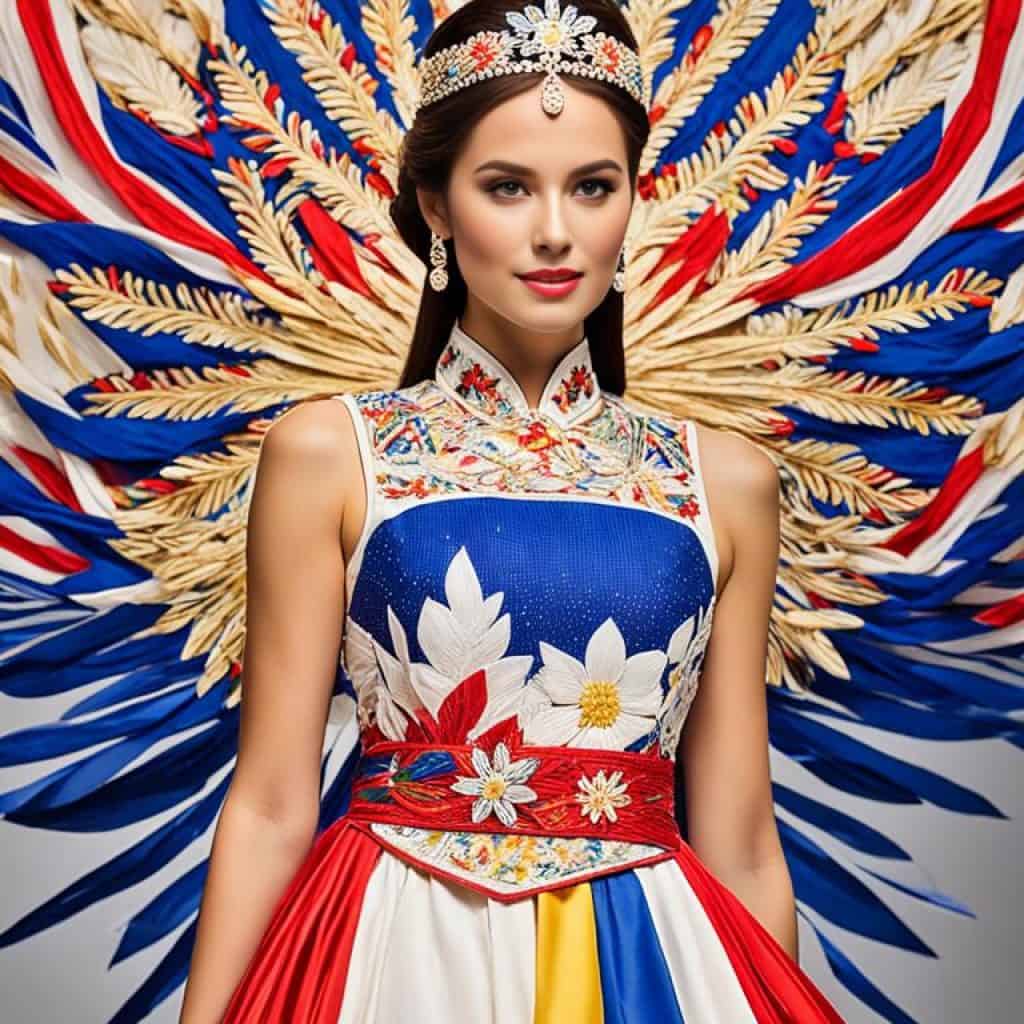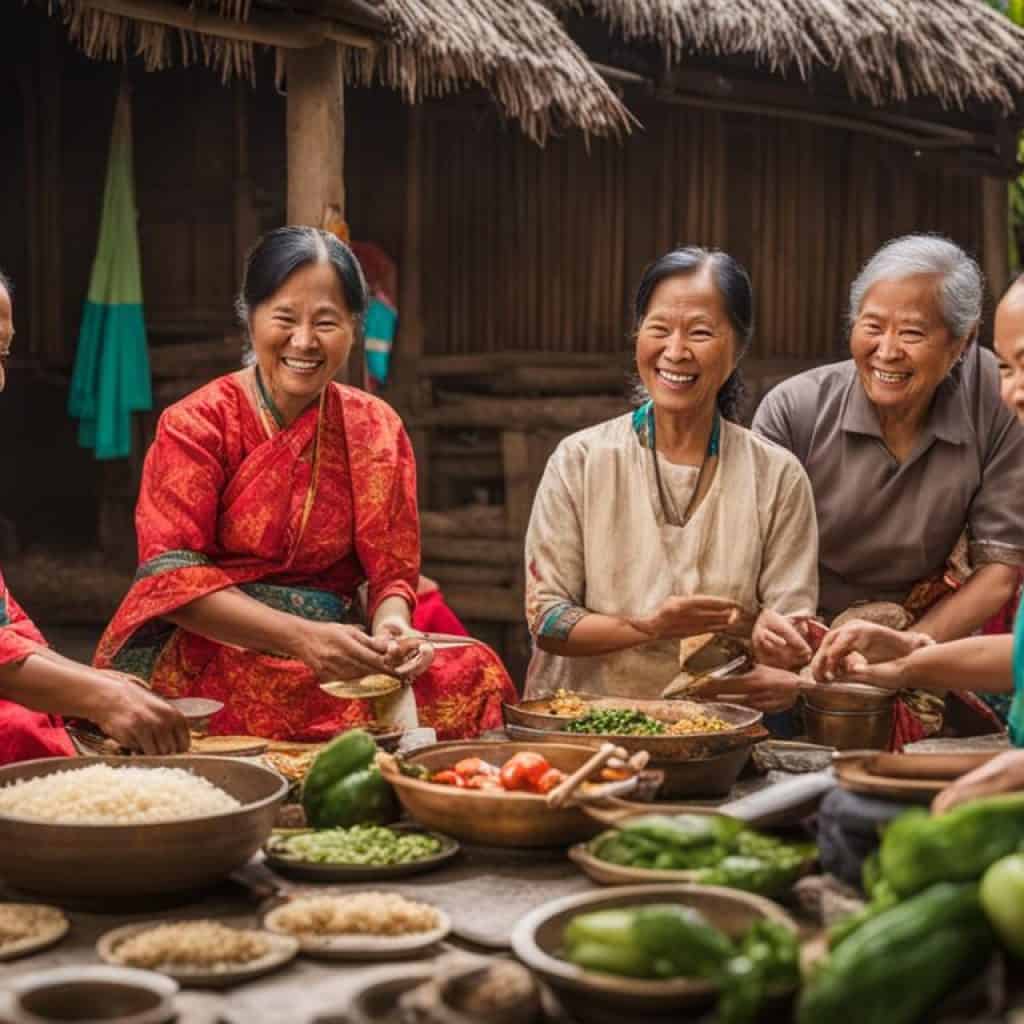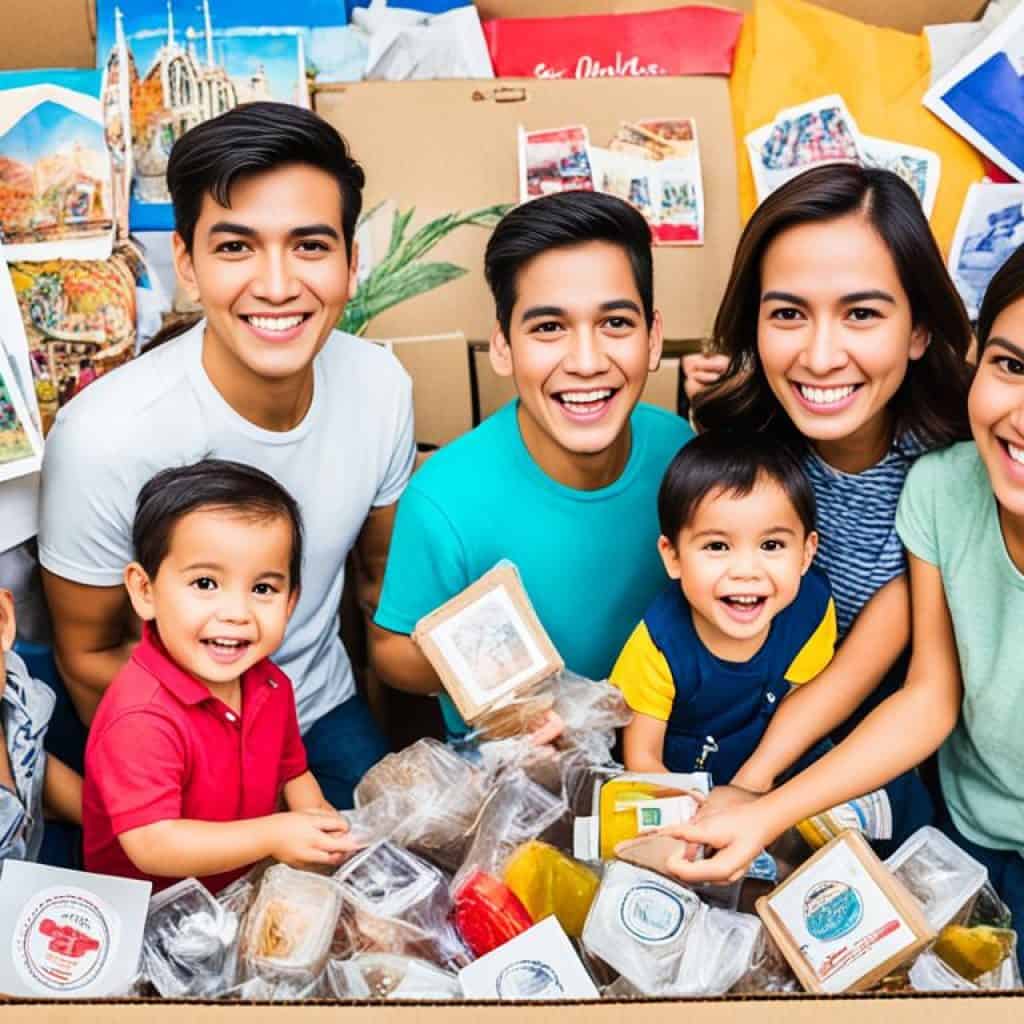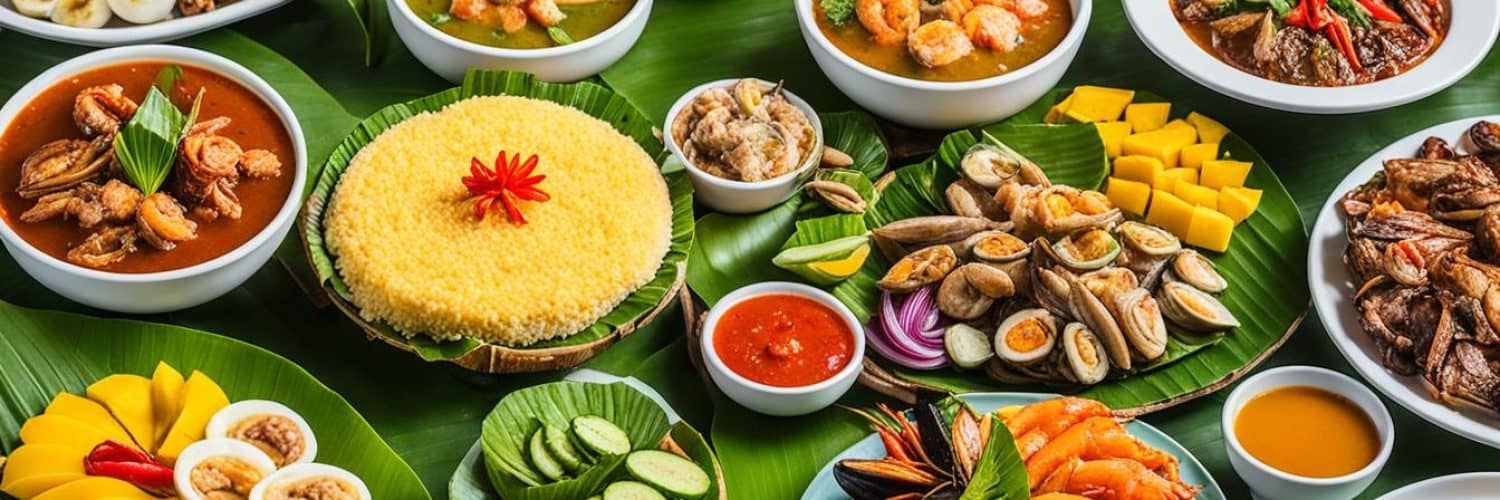Have you ever wondered what makes Filipino life truly unique? From its rich cultural heritage to its vibrant festivals and warm community spirit, Filipino life is an experience like no other. Dive into the captivating world of Philippine culture, explore the customs and values that shape the Filipino way of life, and savor the mouthwatering cuisine that is an essential part of Filipino identity.
Key Takeaways:
- Discover the rich heritage and enduring traditions that define Filipino life.
- Explore the diverse cultural aspects, including family dynamics, daily customs, and gender roles.
- Uncover the fascinating world of Filipino arts, including traditional clothing, visual arts, and performing arts.
- Learn about the unique transportation system in the Philippines and how it reflects the country’s geography.
- Delve into the world of Filipino festivals and celebrations, known for their vibrant atmosphere and cultural significance.
Cultural Diversity in the Philippines
Philippine society is a fascinating blend of cultural diversity and homogeneity. Despite being geographically part of Southeast Asia, the Philippines has a distinct influence of Euro-American culture. Centuries of Western rule have left an indelible mark on the country politically and culturally. This unique combination of Asian heritage and Western cultural acquisitions has shaped the rich tapestry of Philippine society.
The strong Euro-American influence in the Philippines is evident in various aspects of daily life, including language, fashion, music, and even cuisine. The educational system, established during the American colonial period, further reinforced Western ideals and values, contributing to the country’s cultural unity.
Revival of Traditional Practices
Amidst the Euro-American influence, there has also been a resurgence of interest in indigenous traditions and cultural practices. Filipinos have embraced their diverse cultural heritage, recognizing the importance of preserving and celebrating their roots. This revival of traditional arts, music, dance, and rituals has contributed to the country’s vibrant cultural landscape and serves as a testament to the enduring Filipino spirit.
“The strength of a nation lies in its cultural diversity, and the Philippines is a shining example of this unity in diversity. Through the blend of various cultural influences, we have created a unique identity that reflects our past, present, and future.”
The Philippine society stands as a testament to the remarkable ability of different cultures to coexist and thrive together. This cultural diversity is not only a source of pride but also a testament to the resilience and adaptability of the Filipino people.
| Key Influences | Characteristics |
|---|---|
| Euro-American Influence | Shaped the country politically and culturally |
| Cultural Unity | Blend of Asian heritage and Western cultural acquisitions |
| Revival of Traditions | Preservation and celebration of indigenous practices |
Daily Life and Social Customs
Daily life in the Philippines is deeply intertwined with the concept of extended family and the close-knit kinship network. The Filipino culture values strong familial bonds, where the immediate family is just the tip of the iceberg. Parents, grandparents, aunts, uncles, and cousins all play a vital role in the lives of Filipinos, forming an expansive support system that permeates their daily routines and major life events.
Throughout the year, Filipino families come together to celebrate religious holidays, such as Christmas and Easter, which hold immense significance in the culture. These occasions provide an opportunity for family members from near and far to reunite, strengthening their connections and fostering a sense of unity. The vibrant festivities are filled with joy, love, and a shared appreciation for the values and traditions passed down through generations.
One of the highlights of Filipino daily life is the rich and flavorful cuisine that embodies the country’s gastronomic heritage. Filipino cuisine is a delicious fusion of various culinary influences, resulting in unique and mouthwatering dishes. The staple food is typically rice or rice noodles accompanied by an array of meat, fruits, and vegetables, creating a harmonious blend of flavors. From traditional favorites like adobo and sinigang to regional specialties, Filipino cuisine satisfies both the appetite and the soul.
Traditional Filipino Cuisine
| Food | Description |
|---|---|
| Adobo | A quintessential Filipino dish made with meat (often pork or chicken) marinated in soy sauce, vinegar, garlic, and spices, then simmered until tender. It is a flavorful symphony that represents the heart and soul of Filipino cooking. |
| Sinigang | A tangy and savory soup made with tamarind as the base, combined with various vegetables and meat or seafood. Sinigang is known for its refreshing and comforting flavors. |
| Lechon | A centerpiece dish often served during special occasions. It features a whole roasted pig that is crispy on the outside and succulent on the inside, offering an explosion of flavors. |
| Kare-Kare | A rich and creamy stew made with oxtail and/or tripe, peanut sauce, and various vegetables. Kare-Kare is best enjoyed with bagoong, a fermented shrimp paste, adding a perfect balance to the dish. |
| Pancit | A noodle dish that comes in different variations, such as Pancit Canton and Pancit Bihon. It symbolizes long life and is a staple during birthdays and other festive occasions. |
Filipino cuisine is not only a source of nourishment but also a reflection of the country’s diverse cultural influences and vibrant heritage. It is a testament to the Filipino people’s passion for food and the deep connection they have with their culinary traditions.
Traditional Clothing and Arts
In the Philippines, traditional attire is a reflection of the country’s rich cultural heritage and diverse indigenous traditions. While European-inspired clothing has become common, there are unique garments that represent specific regions and ethnic groups. These clothing styles play an important role in preserving Filipino identity and showcasing the vibrant artistic heritage of the country.
A notable example of traditional attire is the malong, a colorful cloth worn by both men and women in Muslim communities. The malong is a versatile garment that can be worn as a skirt, dress, or even a turban. Its vibrant colors and intricate patterns are a testament to the creativity and craftsmanship of Filipino artisans.
Another iconic piece of traditional clothing is the barong, an intricately embroidered shirt typically worn by urban men during special occasions like weddings or formal events. The barong is known for its delicate embroidery, often made with piña or jusi fibers, and is considered a symbol of Filipino elegance and sophistication.

Traditional Arts
In addition to clothing, the Philippines has a thriving artistic scene that encompasses various forms of visual arts, performing arts, and literary works. These artistic expressions are deeply rooted in indigenous traditions and reflect the diverse cultural heritage of the country.
The visual arts in the Philippines encompass a wide range of mediums, including painting, sculpture, and weaving. One notable form of traditional visual art is the baybayin, an ancient script that predates the Spanish colonization. It is a fascinating example of pre-colonial indigenous writing and is still utilized by some communities today.
The performing arts of the Philippines are a captivating blend of music, dance, and theatrical performances. Traditional dances like the Tinikling and the Singkil showcase the grace and skill of Filipino dancers while telling stories that celebrate local traditions and folklore.
“The arts have always been a powerful means of preserving our cultural identity and celebrating our rich heritage.”
Filipino literature, both in Spanish and Filipino languages, has produced notable works that highlight local customs, traditions, and societal issues. The works of Filipino literary giants like Jose Rizal and Nick Joaquin have made significant contributions to the country’s literary heritage.
| Art Form | Description |
|---|---|
| Visual Arts | Painting, sculpture, weaving |
| Performing Arts | Music, dance, theatrical performances |
| Literary Works | Novels, poetry, short stories |
Transportation in the Philippines
Getting around in the Philippines can be an adventure in itself. From public transport to private options, there are various modes of transportation available to suit different preferences and needs.
Public Transport
Public transport is a popular choice for both locals and tourists in the Philippines. However, it can be crowded, especially during peak hours. Here are some common public transport options:
- Buses: Buses are a common mode of transportation, especially for longer distances between cities and provinces. They are often crowded, but they offer affordable fares and convenient routes.
- Jeepneys: Jeepneys are unique to the Philippines and are a cultural icon. These brightly painted vehicles serve as a combination of a bus and a taxi, providing transportation within cities and towns. Jeepneys can be crowded, but they offer an authentic local experience.
- National Railway Service: The Philippines has a national railway service called the Philippine National Railways (PNR). It connects major cities and provinces, providing a convenient option for traveling longer distances.
- Boats and Ferries: With its many islands, traveling by boat or ferry is common in the Philippines. It is a popular mode of transportation for island-hopping and exploring different regions.
Private Transportation and Taxis
For those who prefer more privacy and convenience, private transportation options are available. Driving a car or hiring a taxi or ride-hailing app are common choices:
- Driving: Renting a car or driving your own vehicle gives you the freedom to explore at your own pace. However, be aware that traffic can be congested, especially in urban areas.
- Taxis: Taxis are widely available in cities and towns. They offer a convenient way to navigate through the streets without worrying about parking or directions.
- Ride-Hailing Apps: Ride-hailing apps like Grab and Uber (now acquired by Grab) are also popular in urban areas. These apps allow you to book a car with a driver, providing a hassle-free and reliable transportation option.
Philippine Airlines
For air travel within and outside of the Philippines, the national carrier is Philippine Airlines (PAL). PAL operates domestic and international flights, connecting major cities and popular tourist destinations. It is recognized as one of the leading airlines in the country, offering a range of services and destinations to cater to different travel needs.
Family Dynamics in Filipino Society
In Filipino society, family is highly valued and serves as the foundation of social life. The concept of an extended family plays a vital role, with strong bonds that extend beyond blood relations. Filipinos prioritize the virtue of filial piety, which involves respecting and caring for their elders.
Within many Filipino households, three generations often live together, creating a harmonious and interdependent household structure. This arrangement fosters close relationships and enhances the sense of camaraderie within the family unit.
Transnational families are also prevalent in the Philippines due to overseas labor migration. Many Filipinos work abroad to support their loved ones back home, resulting in the separation of family members. However, despite the physical distance, these families maintain strong connections and support one another emotionally and financially.
The following table highlights the key features of family dynamics in Filipino society:
| Family Aspect | Description |
|---|---|
| Family Foundation | The family unit is the cornerstone of social life in the Philippines. |
| Extended Family | Extended family members play an integral role in the lives of Filipinos. |
| Strong Bonds | Family members share deep emotional connections that extend beyond blood relations. |
| Filial Piety | Respecting and caring for elders is highly valued in Filipino culture. |
| Household Structure | Many Filipino households consist of three generations living together. |
| Transnational Families | Overseas labor migration often leads to the separation of family members, resulting in transnational families. |
The strong emphasis placed on family in Filipino society cultivates a sense of unity, love, and support within households. The bond between family members remains unshakable, even in the face of geographical distances or challenging circumstances.
Gender Roles in the Philippines
Filipino society is often associated with patriarchal norms, but it is important to note that it has evolved closer to an egalitarian society. In fact, influential women play significant roles in various fields, including business and government. Moreover, when it comes to household decision-making, women often take the lead.
The female influence is pervasive throughout the Philippines, shaping the dynamics of the household structure. Many households, particularly those led by women, exemplify the power and wisdom of the oldest female, often the grandmother. Her guidance and nurturing provide a strong foundation for the family, fostering unity, and ensuring the well-being of each member.
“The strength and resilience of Filipino women have shaped our society and continue to inspire future generations.” – Maria Ressa
While there may still be remnants of patriarchal norms, the increasing recognition of influential women and their significant contributions has been transformative. Women in the Philippines have shattered societal stereotypes, proving that gender should never limit one’s potential for success and leadership.
Filipino Women in Business and Government
Filipino women have made remarkable strides in the business world, occupying key positions and leading successful ventures. They have defied the odds through their intelligence, perseverance, and determination. Notable figures such as Tessie Sy-Coson, Vice Chairperson of SM Investments Corporation, and Vicki Belo, a renowned dermatologist and businesswoman, serve as inspirations for aspiring female entrepreneurs.
In the realm of government, influential women have taken the helm, championing policies, and driving change. Corazon Aquino, the first female President of the Philippines, reshaped the political landscape and inspired women across the nation.
Female Influence in the Household
Within Filipino society, the household structure is deeply influenced by the wisdom and strength of women. As mentioned earlier, many households are matriarchal in nature, with the eldest female assuming a prominent role in decision-making and nurturing. This female influence extends beyond the immediate family, nurturing the entire community and creating a sense of unity.
The presence of empowered women in Filipino households not only shapes the dynamics within individual families but also contributes to the overall fabric of society. Their ability to balance various roles and responsibilities is a testament to their resilience, resourcefulness, and dedication to family and community.
Breaking Barriers and Inspiring Change
Filipino society continues to evolve, dismantling patriarchal norms and embracing the power of women. Influential women serve as beacons of hope and inspiration, demonstrating that women can lead, succeed, and make a lasting impact in every aspect of life.
The Filipino society’s progress towards gender equality and the recognition of influential women is a testament to the country’s commitment to creating an inclusive and empowering society. As more and more women break barriers, their accomplishments pave the way for a more equitable future, where gender does not limit one’s potential.

Dating and Marriage in the Philippines
In the Philippines, dating is often accompanied by a traditional courtship process that involves men making efforts to impress women before entering into a relationship. Courtship allows individuals to get to know each other better, and it is a way to show respect, sincerity, and genuine intentions towards the other person. This courtship period may include various activities, such as going on dates, giving thoughtful gifts, and spending quality time together.
Marriage is considered a significant milestone in Filipino culture. It is seen as a lifelong commitment and a union that brings two families together. The Catholic Church, with its strong influence on Filipino society, plays a significant role in shaping marriage practices. Many Filipinos choose to have a religious ceremony in a church, emphasizing their commitment to their faith and the sanctity of marriage.
Monogamy is the prevailing norm in Filipino marriages. Most couples enter into a marital union with the expectation of lifelong fidelity and commitment. Divorce is both socially stigmatized and illegal in the Philippines, reflecting the influence of Catholic values on the country’s legal system. Separation may be possible through legal means, such as annulment.
However, there are changing views regarding marriage in the Philippines. As society becomes more progressive and open-minded, there is increasing acceptance of individual choices when it comes to relationships and remaining single. Some individuals prioritize personal fulfillment, education, or careers and opt to delay or forgo marriage. This shift in perspective reflects the evolving nature of relationships and the diversity of choices that individuals make in contemporary Filipino society.
Traditional Filipino Marriage Practices
| Tradition | Description |
|---|---|
| Pamamanhikan | A formal meeting between the families of the bride and groom to discuss wedding plans and establish rapport. |
| Exchange of Matrimony | The ceremonial exchange of wedding rings, symbolizing the couple’s commitment and unity. |
| Nuptial Mass | A religious ceremony held in a church that solemnizes the marriage and seeks God’s blessing. |
| Veil, Cord, and Coins | Rituals involving the placing of a veil over the couple, the binding of a cord around their shoulders to represent unity, and the giving and receiving of coins symbolizing the couple’s pledge of support and partnership. |
| Wedding Reception | A celebratory gathering where family and friends come together to witness the union and partake in festivities. |
Cultural Institutions in the Philippines
The Philippines is home to a myriad of cultural institutions that are dedicated to the preservation and promotion of its rich heritage. These institutions play a vital role in safeguarding the country’s cultural property and ensuring its legacy for future generations. From the iconic National Museum to local museums scattered across various provinces, the Philippines is a treasure trove of cultural artifacts and historical treasures.
The National Museum in Manila stands as a testament to the importance of preserving the cultural heritage of the Philippines. It houses a significant ethnographic collection that celebrates the diverse cultures and traditions found throughout the country. The museum’s vast array of exhibits showcases the richness and depth of Filipino art, history, and culture.
“Preserving our cultural heritage is crucial for understanding our past, shaping our present, and building our future. The National Museum serves as a beacon of knowledge, offering a glimpse into the vibrant tapestry of Filipino identity.”
In addition to the National Museum, many provinces in the Philippines have their own local museums that highlight the unique heritage of their respective regions. These museums showcase the distinct traditions, customs, and artistic expressions that make each locality special. From ancient artifacts to contemporary works of art, these cultural institutions offer a deeper understanding of the local communities and their contributions to the country’s cultural tapestry.
The Philippines is also home to several UNESCO World Heritage sites, which are recognized for their outstanding universal value. These sites are a testament to the rich history and unique cultural significance of the Philippines. From the stunning rice terraces of Ifugao to the well-preserved 16th-century town of Vigan, these sites offer a glimpse into the country’s past and the preservation efforts undertaken to protect these cultural treasures.
Local organizations and historical groups also play a vital role in preserving the cultural heritage of the Philippines. These dedicated individuals work tirelessly to ensure the protection and conservation of cultural properties, artifacts, and historical landmarks. Through their efforts, the cultural legacy of the Philippines is safeguarded for future generations to explore, learn from, and cherish.
The National Museum and Local Museums in the Philippines
| Location | Description |
|---|---|
| Manila | The National Museum in Manila houses an extensive collection of ethnographic artifacts and artworks that represent the diverse cultural heritage of the Philippines. |
| Quezon City | The Ninoy Aquino Parks and Wildlife Center features a museum that showcases the country’s abundant biodiversity through interactive exhibits and dioramas. |
| Cebu | The Museo Sugbo offers an insightful journey through the history of Cebu, featuring exhibits on Spanish colonialism, the Japanese occupation, and local Cebuano culture. |
| Bohol | The Bohol National Museum exhibits a wide range of artifacts, including archaeological finds, traditional costumes, and religious art from the region. |
In conclusion, the cultural institutions of the Philippines, such as the National Museum and local museums, UNESCO World Heritage sites, and the efforts of dedicated organizations and historical groups, play a crucial role in preserving and promoting the country’s rich cultural heritage. These institutions and individuals ensure that the cultural properties and artifacts are protected and available for future generations to appreciate and learn from.
Filipino Community Abroad
The Philippines has witnessed a significant number of its citizens seeking opportunities abroad through overseas labor migration. As a result, Filipino families have become transnational, with some members working abroad while others remain in the Philippines. Despite the physical distance, maintaining connections with their left-behind families remains a priority for Filipinos overseas.
One of the ways Filipinos show their love and support for their families back home is through the popular tradition of sending “balikbayan boxes.” These care packages are filled with items such as food, clothing, toiletries, and other essentials. The balikbayan box serves as a tangible symbol of love and connection, reminding families of their bond despite the physical distance.

Benefits of Balikbayan Boxes:
- Provides essential goods and support for families in the Philippines
- Brings a sense of connection and comfort to loved ones back home
- Allows Filipinos abroad to contribute to the well-being of their families
- Preserves the strong family ties and values that are foundational in Filipino culture
Through the act of sending balikbayan boxes, Filipinos abroad bridge the physical distance and maintain their connection to their families and home country. It is a beautiful testament to the enduring bonds and deep love that characterize Filipino transnational families.
Traditional Beliefs and Mythology
Filipino society is steeped in a rich tradition of myths, legends, and folklore that has been passed down through generations. These captivating stories explore a wide range of subjects, from the origin of the world and creation stories to tales of heroic feats and mythical creatures. Mythology holds a special place in the hearts of Filipinos, serving as a testament to their cultural heritage and deep-rooted beliefs.
Each region in the Philippines has its own unique set of myths and legends, reflecting the diverse cultural tapestry of the country. These stories offer profound insights into the historical and mythological world of each region, providing glimpses into their past and shaping their present identity. Whether it’s the epic adventures of the Bicolanos’ “Ibalong” or the enchanting tales woven by the Visayans in the “Hinilawod,” Filipino mythology is a treasure trove of captivating stories.
The origin stories found in Filipino mythology elucidate the creation of the world and the existence of its inhabitants. These tales often involve supernatural beings, gods, and goddesses who shape the world with their actions and embody moral values and lessons. They provide a cultural framework that allows Filipinos to understand their place in the universe, appreciate the interconnectedness of all things, and instill virtues that guide their daily lives.
Traditional folk heroes also feature prominently in Filipino mythology, revered for their bravery, wisdom, and selflessness. These legendary figures embody Filipino values and serve as role models to inspire courage and resilience in the face of adversity. Prominent examples include the legendary hero Lam-ang from the epic “Biag ni Lam-ang” and the valiant Bernardo Carpio, who is said to be trapped between two mountains, using his strength to keep them from colliding.
“Filipino mythology is a testament to the rich cultural heritage and deep-rooted beliefs of the Filipino people. The captivating stories that have been passed down through generations showcase the country’s diverse traditions and provide valuable insights into its history and worldview.”
In conclusion, Filipino myths and legends, origin stories, cultural tales, and traditional folk heroes are an integral part of Filipino society. These stories not only entertain but also educate, instilling values and cultural identity in each generation. They offer a glimpse into the vibrant tapestry of Filipino culture and serve as a reminder of the rich heritage that has shaped the beliefs and perspectives of the Filipino people.
Filipino Film Industry and Arts
The Philippines has gained international recognition for its exceptional contributions to the film industry and the arts. Through compelling storytelling and authentic narratives, Filipino films have captivated audiences around the world, showcasing the rich and diverse culture of the country.
However, the film industry in the Philippines also faces several challenges. High production costs and rampant piracy have hindered the growth and profitability of the industry. Despite these obstacles, filmmakers and artists in the Philippines continue to persevere, using their creativity and passion to overcome these challenges.
The visual arts play a significant role in Filipino culture, with talented painters and sculptors showcasing their skills and creativity. The Philippines boasts a vibrant and thriving arts scene, with galleries and exhibitions providing platforms for artists to display their works. From traditional to contemporary art forms, the visual arts in the Philippines reflect the country’s rich heritage and artistic expression.
Literary works also hold a special place in Filipino arts and culture. Filipino writers have produced notable works in both English and Filipino languages, capturing the essence of Filipino life and society. These literary pieces explore themes of identity, history, and the complexities of human existence.
The performing arts, including traditional and contemporary forms, thrive in the Philippines. Dance, theater, music, and film contribute to a dynamic and vibrant performing arts scene. Traditional dances, such as the Tinikling and the Singkil, showcase the indigenous culture of the Philippines, while contemporary performances push boundaries and explore new artistic expressions.
The Filipino film industry and arts play a crucial role in preserving and celebrating the cultural heritage of the Philippines. Through internationally acclaimed films, visual arts, literary works, and performing arts, Filipino artists continue to inspire and connect people across borders, bringing the beauty and uniqueness of Filipino culture to a global audience.
Filipino Cuisine
Filipino cuisine is a culinary delight that showcases the country’s rich culinary heritage influenced by various cultures. With a diverse range of flavors, Filipino dishes offer a unique gastronomic experience that satisfies both locals and visitors alike.
At the heart of Filipino meals is rice, the staple food that accompanies various dishes. Whether it’s steamed, fried, or made into rice noodles, rice forms the foundation of many Filipino meals. Combined with an array of meats, vegetables, and sauces, Filipino dishes create a harmonious blend of flavors.
But it’s not just the main courses that define Filipino cuisine. Street food plays a significant role in showcasing the vibrant food culture of the Philippines. Whether it’s the infamous balut (a fertilized duck egg), skewered meats like pork barbecue, or local desserts like halo-halo (a mixed shaved ice dessert), the streets of the Philippines offer an array of delicious and unique flavors.
Experience the vibrant Filipino cuisine and indulge in the diverse flavors that reflect the country’s culinary heritage. From traditional dishes to street food delights, Filipino cuisine will surely tantalize your taste buds and leave you craving for more.
Must-Try Filipino Dishes:
- Adobo – A flavorful dish of meat (commonly chicken or pork) marinated in vinegar, soy sauce, garlic, and spices.
- Sinigang – A sour soup made with tamarind, tomatoes, and various vegetables, typically cooked with pork or shrimp.
- Lechon – A whole roasted pig with crispy skin and succulent meat, often served as the centerpiece of special occasions.
- Kare-Kare – A hearty stew made with oxtail, tripe, or beef, thickened with ground peanuts, and served with a side of bagoong (shrimp paste).
- Pancit – Various noodle dishes with Chinese influences, such as Pancit Canton, Pancit Bihon, and Pancit Malabon.
- Halo-Halo – A refreshing dessert made with layers of shaved ice, sweetened beans, fruits, jellies, and topped with evaporated milk and leche flan.
“Filipino cuisine is a delicious fusion of flavors that reflects the country’s diverse culinary heritage.” – Chef Maria Santos
Filipino Festivals and Celebrations
The Philippines is renowned for its lively festivals and vibrant celebrations, showcasing the rich cultural heritage and traditions of the Filipino people. These festive events bring together communities and visitors from all over the world, creating a vibrant atmosphere filled with music, dance, and colorful parades.
Religious festivals hold a significant place in Filipino culture, with Christmas and Easter being widely celebrated throughout the country. These religious events are marked by solemnity as well as joyous gatherings, where families and friends come together to commemorate the birth and resurrection of Jesus Christ.
In addition to religious events, each region in the Philippines has its own unique fiestas that highlight local traditions and customs. These regional festivals are an opportunity for communities to showcase their distinct cultural identity and heritage. From the energetic Ati-Atihan festival in Aklan to the colorful Panagbenga flower festival in Baguio City, these celebrations captivate visitors with their stunning displays of art, music, and dance.
One of the most famous festivals in the Philippines is the Sinulog festival in Cebu City, which honors the Santo Niño (Child Jesus). During this grand celebration, participants don vibrant costumes and engage in lively street dances, accompanied by rhythmic drumming and chanting. The Sinulog festival attracts tourists from around the world who come to witness the exuberant festivities.
“The Filipino festivals are a testament to the country’s vibrant culture and the strong sense of community among its people,” says Juan Dela Cruz, a cultural enthusiast.
“These celebrations not only serve as avenues for showcasing our traditions and regional pride, but they also bring joy and unity to Filipinos and foreigners alike. The atmosphere during these festivals is electrifying, with everyone immersed in the contagious energy of music, dance, and revelry.”
Whether it’s the pulsating beat of drums at the Pahiyas festival in Lucban or the mesmerizing street performances at the Kadayawan festival in Davao City, Filipino festivals offer a unique and unforgettable experience that immerses visitors in the country’s vibrant cultural tapestry.
Must-Visit Filipino Festivals
Education and Cultural Progress
In the Philippines, education is highly valued as a catalyst for cultural progress. The country recognizes the significance of an effective educational system in shaping its cultural identity and fostering socioeconomic advancement. Through a combination of efforts from the United States and local initiatives, the educational system in the Philippines has played a crucial role in promoting cultural unity and facilitating societal growth.
The commitment to arts development and literature further enriches the cultural landscape of the Philippines. Numerous awards and institutions recognize and celebrate the talent of Filipino writers, artists, and musicians, showcasing their contributions to the nation’s artistic heritage. Their creative works are a testament to the collective imagination and the vibrant spirit of the Filipino people.
“Education is the passport to the future, for tomorrow belongs to those who prepare for it today.” – Malcolm X
The educational system in the Philippines not only equips students with academic knowledge but also instills a sense of cultural pride and identity. Through the study of literature, history, and the arts, students develop an appreciation for their cultural heritage and contribute to the preservation and celebration of Filipino culture.
The development of arts and literature strengthens the cultural fabric of the Philippines, allowing the nation to continue flourishing as a hub of creativity and expression.
| Literary Work | Author | Genre |
|---|---|---|
| Noli Me Tangere | Jose Rizal | Novel |
| Ang Pagdadalaga ni Maximo Oliveros (The Blossoming of Maximo Oliveros) | Michiko Yamamoto | Film screenplay |
| Ang Larawan (The Portrait) | Nick Joaquin | Play |
The literary works listed above are just a few examples of the remarkable contributions of Filipino authors to the world of literature. These works have not only garnered national acclaim but have also resonated with readers and audiences globally. They explore various themes, including social issues, historical events, and the complexities of human nature, providing valuable insights into Filipino culture and society.
Institutions Supporting Cultural Progress
Several institutions in the Philippines actively support the development and preservation of arts and culture. These institutions play a vital role in nurturing artistic talent, promoting cultural understanding, and showcasing the Philippines’ diverse creative expressions. Some notable institutions include:
- Cultural Center of the Philippines
- National Commission for Culture and the Arts
- University of the Philippines College of Fine Arts
- Philippine High School for the Arts
Through their programs, exhibitions, and initiatives, these institutions contribute to the continuous growth and evolution of the Filipino arts scene.
Conclusion
Filipino life is a vibrant tapestry of culture, traditions, and heritage. With its enduring traditions and rich heritage, the Philippines embodies a vibrant culture that is truly unique. From the strong emphasis on family and community to the dynamic arts scene, Filipino life is a celebration of togetherness and a testament to the festive spirit that permeates the country.
Embracing the vibrant Filipino life is an invitation to immerse oneself in a culture that cherishes its past, embraces its present, and looks forward to a colorful future. The enduring traditions passed down through generations enrich the daily lives of Filipinos, creating strong bonds within families and communities. This vibrant culture is showcased in the diverse art forms, from traditional music and dances to visual arts and literary works.
As one explores Filipino life, they will encounter a rich tapestry of festivals and celebrations that showcase the country’s cultural diversity. The vibrant atmosphere of these events, filled with music, dance, and colorful parades, reflects the true spirit of the Filipino people. It is through these celebrations that the festive spirit of Filipino life truly comes alive.
In the heart of Filipino life, one will find a vibrant culture that is rooted in enduring traditions and a rich heritage. It is this spirit of celebration, togetherness, and resilience that defines Filipino life and makes it truly special. Whether it is the strong emphasis on family, the dynamic arts scene, or the colorful festivals, the vibrant Filipino life is an experience that should be cherished and celebrated.
FAQ
What are some examples of Filipino traditions and values?
Examples of Filipino traditions include extended family gatherings for major life events and religious holidays. Filipino values emphasize the importance of respect for elders and strong kinship bonds.
What is the significance of Filipino cuisine in daily life?
Filipino cuisine, with its staple of rice accompanied by meat, fruits, and vegetables, is an integral part of daily meals in the Philippines. It reflects the country’s culinary heritage and diverse flavors.
What are some traditional clothing and arts in the Philippines?
Traditional clothing in the Philippines includes garments like the malong and barong, which represent specific regions and ethnic groups. The country also has a rich artistic heritage, with traditional music, dances, and visual arts.
What are the modes of transportation in the Philippines?
The Philippines has a variety of transportation options, including public buses, jeepneys, and boats and ferries for inter-island travel. The country also has a national railway service and Philippine Airlines for air travel.
How does family play a role in Filipino society?
Family holds great importance in Filipino society, with close-knit kinship networks and extended family members playing a central role. Filipinos prioritize filial piety and often have multi-generational households or transnational families due to overseas labor migration.
How do gender roles manifest in Filipino society?
While Filipino society exhibits some patriarchal norms, it is also characterized by a strong influence of women in business, government, and household decision-making. Many households are led by women, particularly the oldest female.
What are the dating and marriage practices in the Philippines?
Dating in the Philippines often involves a courtship process, and marriage is considered a significant milestone. The Catholic Church has a strong influence on marriage practices, and divorce is both socially stigmatized and illegal.
How does the Philippines preserve its cultural heritage?
The Philippines has various cultural institutions, such as the National Museum, that house ethnographic collections and preserve cultural heritage. Local museums, UNESCO World Heritage sites, and historical groups also contribute to heritage preservation.
How does the Filipino community maintain connections abroad?
Due to overseas labor migration, many Filipino families are spread across the world. Filipinos abroad often maintain connections with their families in the Philippines through various means, including sending “balikbayan boxes” filled with items of support.
What are some traditional beliefs and mythology in the Philippines?
Filipino society has a rich tradition of myths, legends, and folklore, covering subjects like the origin of the world and traditional folk heroes. Different regions have their own epics and tales that showcase the diverse cultural heritage of the Philippines.
What is the significance of the Filipino film industry and arts?
The Filipino film industry has produced internationally acclaimed films that tell stories rooted in Filipino culture and experiences. The country also has a vibrant arts scene, with talented painters, sculptors, writers, and performing artists contributing to the cultural landscape.
What is unique about Filipino cuisine?
Filipino cuisine is diverse and reflects the country’s culinary heritage influenced by various cultures. From the staple dish of rice accompanied by meat and vegetables to regional specialties like adobo and sinigang, Filipino food offers a unique blend of flavors. Street food culture is also vibrant in the Philippines.
What are some popular festivals and celebrations in the Philippines?
The Philippines is known for its vibrant festivals and celebrations. From religious events like Christmas and Easter to regional fiestas that showcase local traditions and customs, Filipino festivals are marked by a lively atmosphere of music, dance, and colorful parades.
How does education contribute to cultural progress in the Philippines?
Education is highly valued in the Philippines as a means of cultural progress. The educational system, established with influences from the United States, fosters cultural unity and socioeconomic progress. The country also supports the development of arts and literature through awards and institutions.
What defines the vibrant Filipino life?
Filipino life is a vibrant tapestry of culture, traditions, and heritage. From the strong emphasis on family and community to the rich arts scene and enduring values, the Philippines offers a unique and dynamic way of life that embodies the spirit of celebration and togetherness.


















Add comment